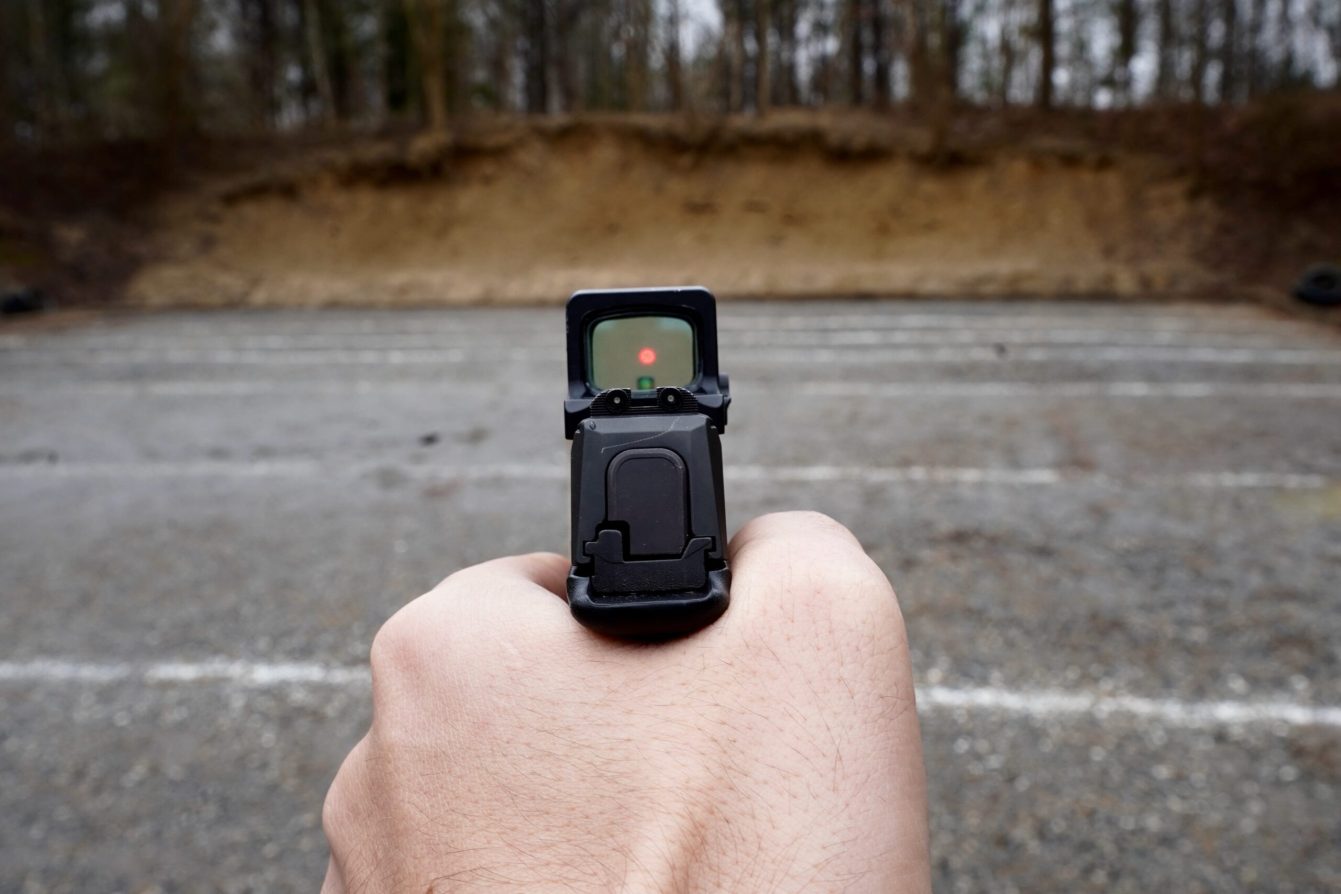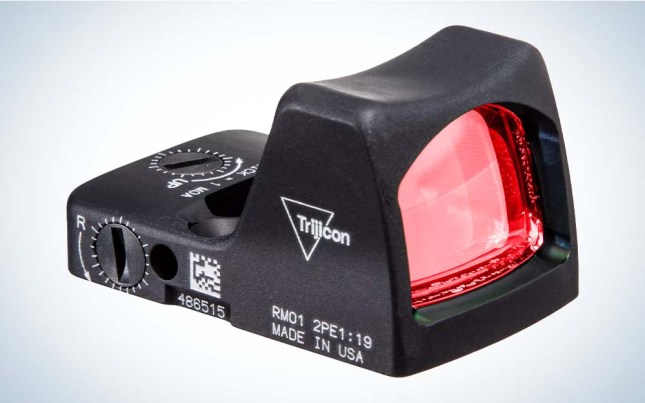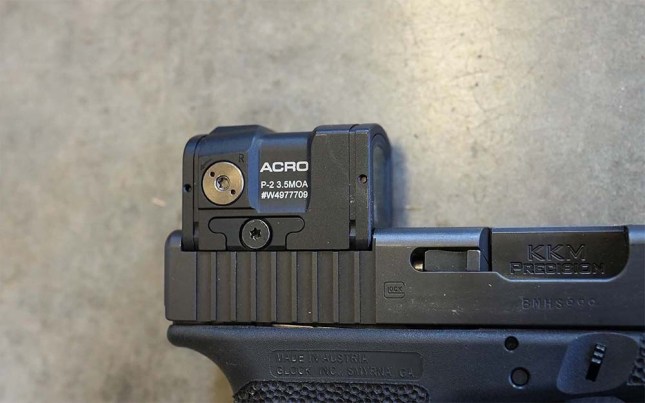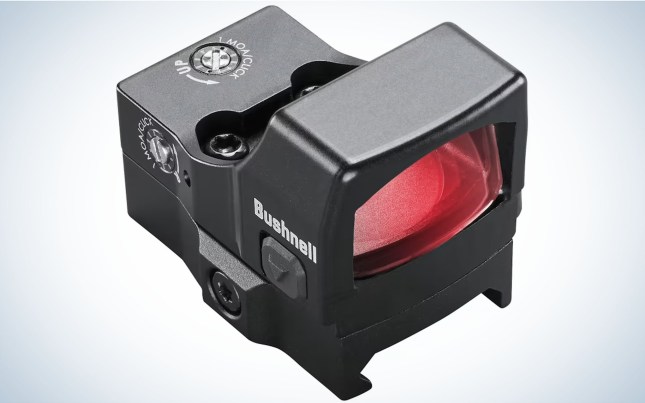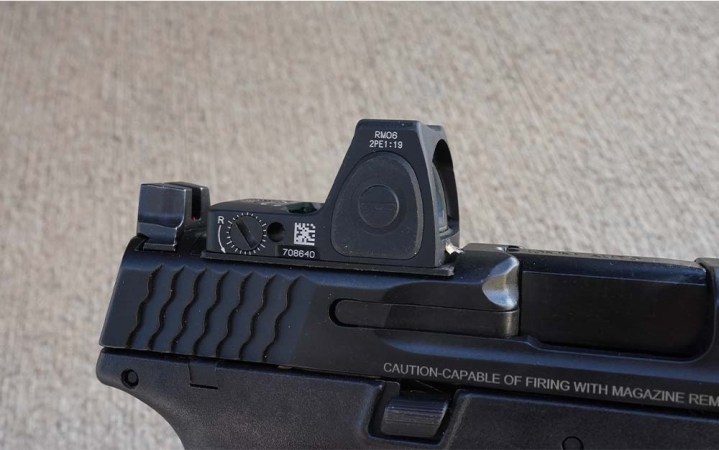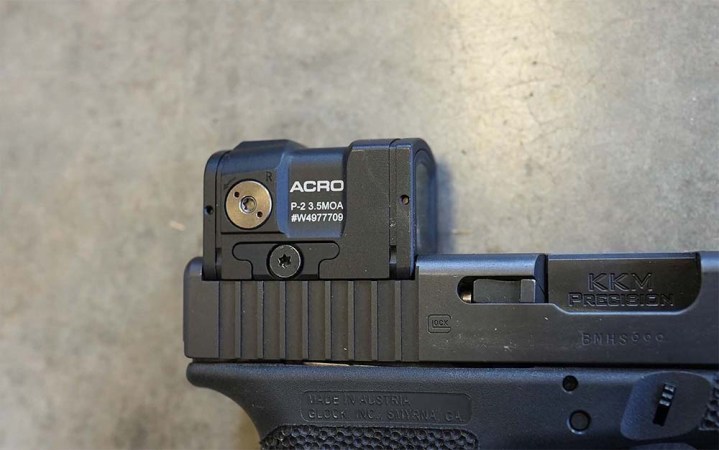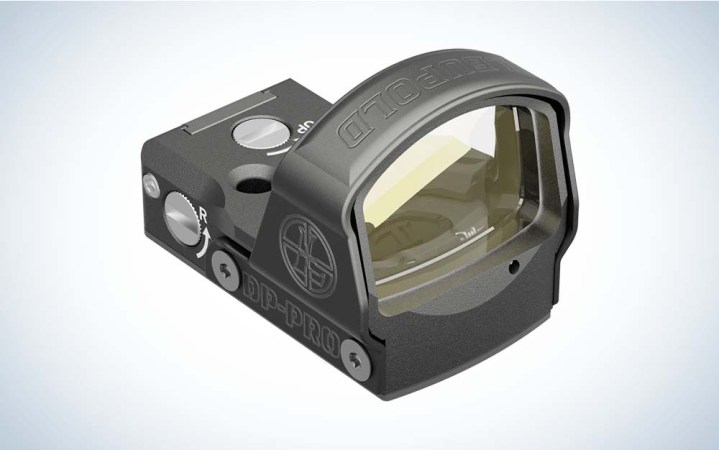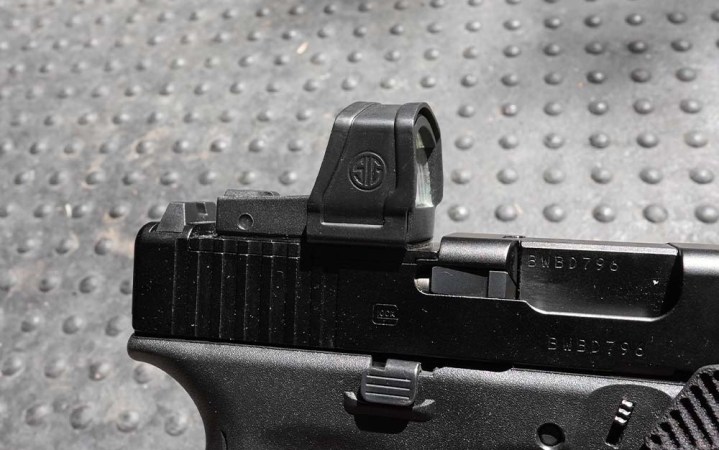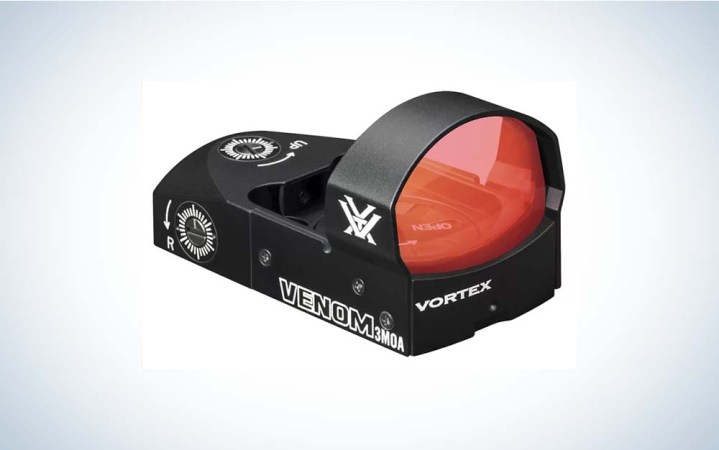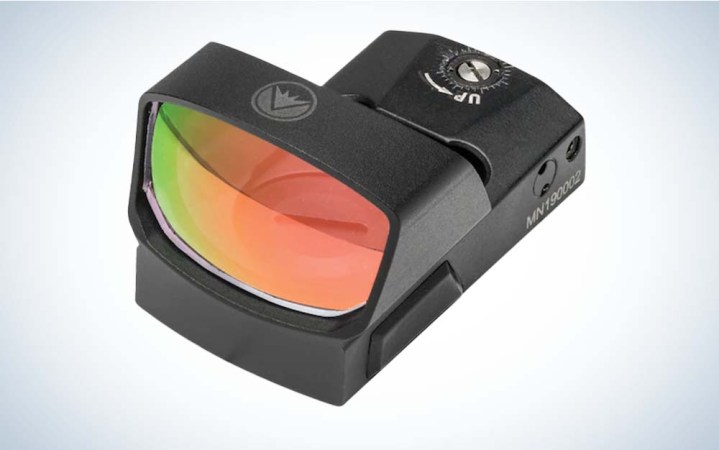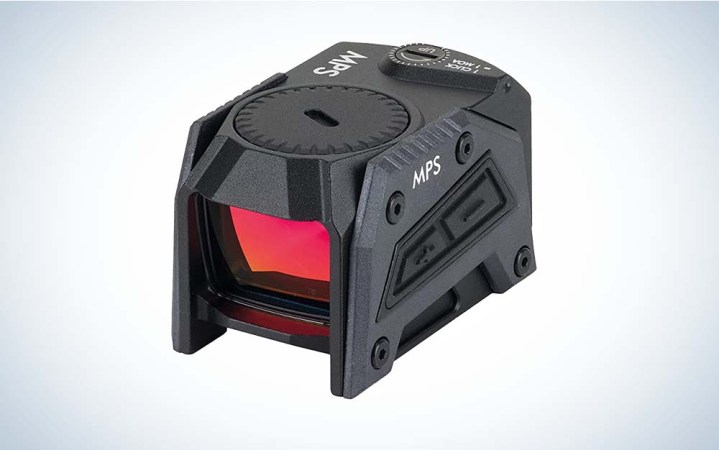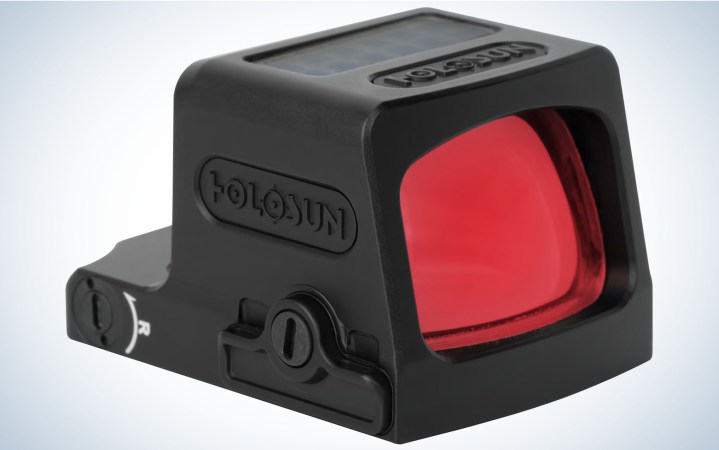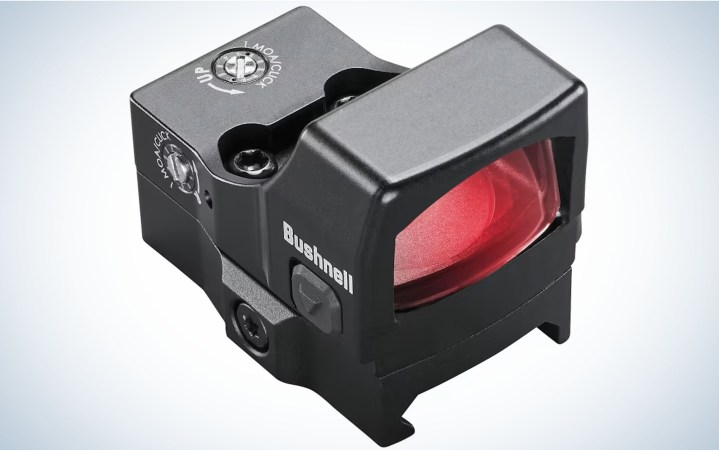We may earn revenue from the products available on this page and participate in affiliate programs. Learn More ›
A decade ago, pistol red dots were little more than a novelty for the average shooter. If you weren’t trying to achieve dominance at the Steel Challenge while shooting something like a tricked-out Caspian 1911 comp gun in .38 Super, you didn’t have much use for a red dot. Things have changed.
The concept of using a reflex or projected red dot sight for a pistol was always a good one, but the technology wasn’t advanced enough to make them practical for the everyday shooter. The sights weren’t compact or durable enough for carry-gun use. Some of the old competition pistol red dots are larger than what many shooters have on their carbines today. Another challenge for would-be red-dot shooters was mounting the optics. Any standard carry pistol had to be custom milled, drilled, and tapped to host a red dot sight.
As rugged and compact pistol red dots, led by the Trijicon RMR, trickled onto the market, more shooters began adopting them. Within the last few years, the market has exploded, and many pistols ship in optics-ready configurations as a standard. Shooting pistols with red dots has a learning curve but with practice, compared to iron sights, most good red dots can help a person aim quicker and shoot more accurately. Contemporary pistol red dots are rugged, reliable, versatile, and sport a long battery life. Each has its pros and cons, but a broad market means lots of choices for you.
- Best Overall: Trijicon RMR Type 2
- Best Enclosed Emitter: Aimpoint ACRO P-2
- Best for Fast, Close Shooting: Leupold DeltaPoint Pro 6 MOA
- Best for Competitive Shooting: Trijicon SRO
- Best Lightweight: Sig Sauer Romeo Zero Elite
- Excellent All-Around Sight: Vortex Venom
- Most Versatile: Burris Fastfire 4
- Ultra-Rugged: Steiner MPS
- Best Compact Enclosed Emitter: Holosun EPS Carry
- Best Value: Bushnell RXS-250
Best Pistol Red Dots: Reviews & Recommendations
Best Overall: Trijicon RMR Type 2
Key Features
- Weight: 1.2 ounces
- Objective Lens Size: .83 x .63 inches
- Reticle: 1, 3.25, or 6 MOA dot
- Adjustment: Eight settings, two for night vision
- Battery Life: Four years
- Battery: CR 2032
Pros
- Built for hard use
- Good ergonomics
- Great engineering
Cons
- Expensive
After spending months testing the best pistol red-dots, I had to pick one as the winner. It’s a Sophie’s Choice scenario for sure—but rules are rules, and the Trijicon RMR Type 2 got the nod as the overall best red dot sight. The Trijicon RMR Type 2’s distinctive features set it apart from the rest of the field and justify its lofty price tag.
For starters it’s difficult to find anything to criticize about this sight, other than perhaps its price. But you get what you pay for, and when you slap your money down for one of these, you’re getting a hell of a unit.
The RMR sights have a couple of distinctive features compared to the rest of the field. One is the drain holes on either side of the housing that keep water and other debris from collecting around the emitter. The other is the curious shape of the housing, with its concave top. Both these elements hint toward the end users that Trijicon had in mind when developing the sights: serious professionals who rely on them for their lives.
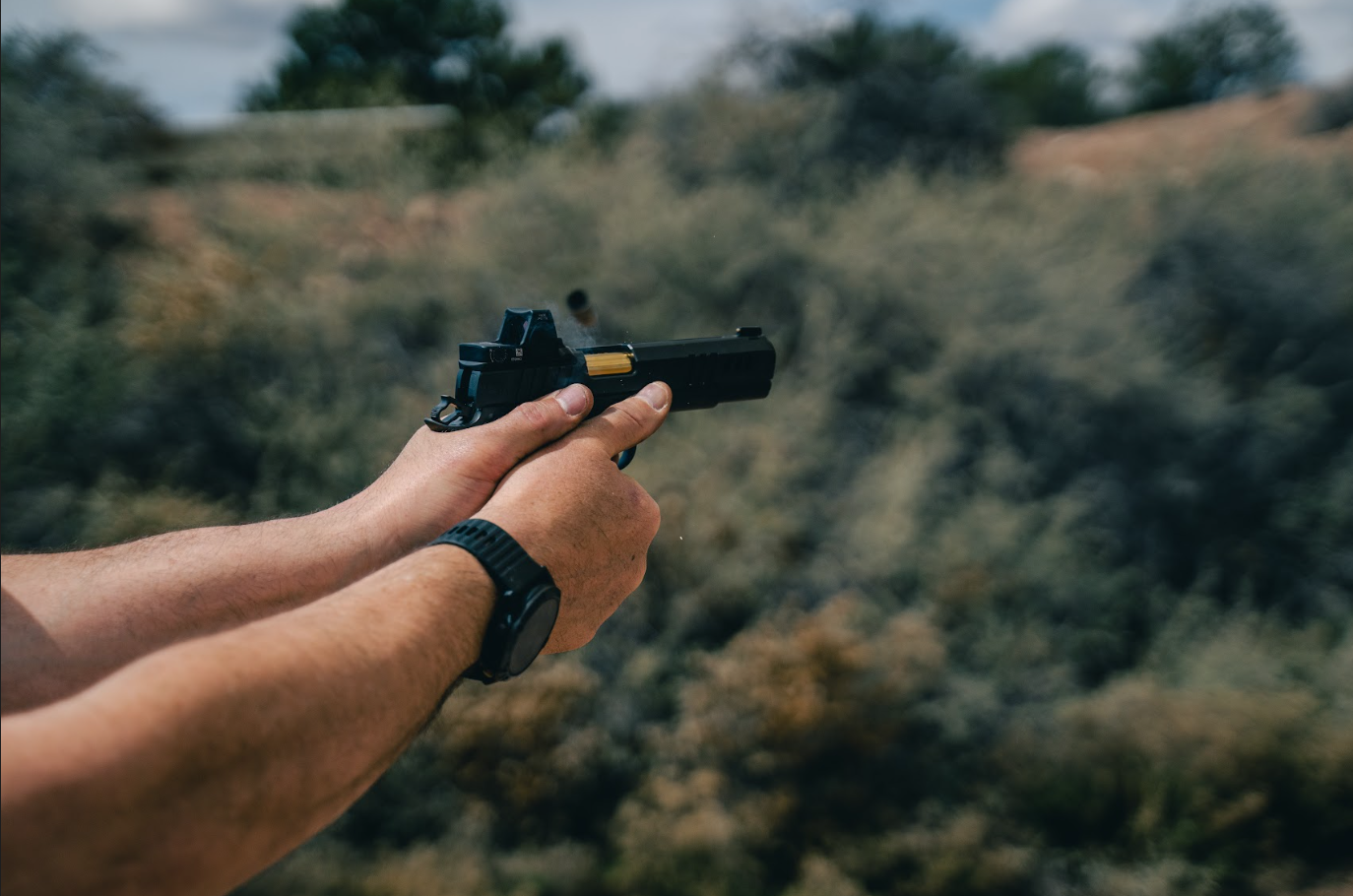
The utility of the drain ports is obvious. Whether Marines are on patrol in a swamp or a Special Operations unit is using scuba gear, they want their sights to be clear and good to go at all times. The shape of the housing mitigates hard impacts and protects the glass from damage. The Trijicon RMR Type 2 is rated waterproof to 20 meters (66 feet).
There are a couple dozen different variants of the Type 2 to pick from with various mounting systems and dot sizes. It can be had with 1, 3.25, or 6.5 MOA dots. Mine, a 3.25 MOA dot, is bright and crisp. The unit has minimal optical distortion (though the glass does have a noticeable blue tinge), eight brightness settings to pick from (including two for night vision), and a four-year run time from a CR 2032 battery. If desired, the sight can be set to an automatic mode that adjusts reticle brightness based on ambient light.
If you’re looking for a pistol or small arms sight that can do it all—personal protection, concealed carry, target shooting, hunting—the RMR Type 2 is it.
Best Enclosed Emitter: Aimpoint ACRO P-2
Key Features
- Weight: 2.1 ounces
- Objective Lens Size: 15x15mm
- Reticle: 3.5 MOA dot
- Adjustments: 10 settings, four for NV
- Battery Life: 50,000 hours
- Battery: CR 2032
Pros
- Extremely rugged
- Great optical clarity
- Excellent ergonomics
Cons
- Pricey
When I was putting together a new handgun for bear protection, I topped it with this sight. The Aimpoint ACRO P-2 checks all the boxes I need and excels in terms of reliability and survivability.
The main virtue of an enclosed emitter is that it is protected from the environment. I spend a lot of time in grizzly country, both in the mountains and in low-lying river bottoms. Between the snow that’s typical at elevation and the mud and debris that’s part of any river system, there are a lot of ways for a red dot to get clogged with gunk. The ACRO P-2 has flat windows on either side of the unit that can easily be wiped with a shirt sleeve to clear the glass.
The ACRO also has best-in-class waterproofing. It is submersible to 35 meters (115 feet) so you can dunk it without harming it in any way. The P-2 also has much improved battery life over the original ACRO and can deliver up to five years of service on a single CR 2032.
The 3.5 MOA dot has round, crisp edges, though when the intensity level is jacked up to the max (there are 10 settings, four of which are for night vision), the dot has a fair bit of blooming. On the plus side, there isn’t any lighting situation where the ACRO’s dot will wash out. The buttons that control the dot intensity give very positive feedback, which allows them to be manipulated while wearing gloves.
The optical clarity of the unit is among the best in the field. There is very little color distortion and no optical distortion while looking through the sight. Picking up the dot and recovering it while shooting is a snap. It is very forgiving.
All this performance, however, comes at a cost. The ACRO P-2 is among the most expensive red dots out there, but it is a serious professional-grade tool that is well worth it.
Best for Fast, Close Shooting: Leupold DeltaPoint Pro 6 MOA
Key Features
- Weight: 2 ounces
- Objective Lens Size: 20mm
- Reticle: 6 MOA dot
- Adjustment: 8 settings
- Battery Life: 1,600 hours
- Battery: CR 2032
Pros
- Excellent optical quality
- Large, bright aiming point
- Convenient battery compartment
Cons
- Expensive
- Sits high on the pistol
Like all Leupold DeltaPoint’s, this model is wonderfully engineered. The toolless battery compartment/adjustment button is convenient and clever. Pushing on the button allows the shooter to cycle through eight different brightness settings.
The coin-slot windage and elevation adjustments have 60 MOA of travel. They adjust in 1 MOA clicks and give excellent tactile feedback when turned.
The battery life figures that Leupold gives are much lower (and more realistic, to be honest) than you’ll see with other sights, but it’s worth keeping the dot brightness to a lower setting or making a point to turn off the sight when not in use to get more from the battery.
To harden the sight, Leupold encloses it in a metal shield that wraps over the optic. This bumps the weight to 2 ounces, making it one of the heavier open-emitter sights in the test.
Best for Competitive Shooting: Trijicon SRO
Key Features
- Weight: 1.6 ounces
- Objective Lens Size: 26mm
- Reticle: 1, 2.5 or 5 MOA dot
- Adjustment: Eight brightness levels, two for night vision
- Battery Life: 3 years
- Battery: CR 2032
Pros
- Generous sized objective lens
- Great ergonomics
- Tough
Cons
- Spendy
Looking through the Trijicon SRO is like staring out of a large picture window with mountain views. It’s a thing of beauty. The generously sized objective lens measures 26 mm in diameter making it easy to find and reacquire the dot during rapid shooting. That quality is a big part of the reason why the SRO is my top choice for competition. In addition to that is the bomb-proof construction and top-notch engineering of all Trijicon’s best pistol red dots.
The SRO is offered with three sized dots depending on your needs: 1 MOA, 2.5 MOA, or 5 MOA. I opted for the 2.5 MOA model, which strikes a great balance between size and precision and handles any shooting chore well.
For a larger sight, the SRO manages to sit relatively low on the slide. That makes sighting through the window that much faster and helps the sight co-witness with irons more easily.
The SRO has a tiny bit of optical distortion, but not enough to detract from the sight’s performance. In fact, with its large objective lens, the SRO handled tracking and target transitions better than any other red-dot in the test.
The ergonomics on the unit are fabulous as well. The windage and elevation adjusters have medium-sized slots that can accommodate a regular screwdriver bit or thin coin and offer positive feedback with each click. The sight has 150 MOA of w/e travel with each click moving the sight 1 MOA. The battery tray is easy to access and doesn’t have to be removed from the pistol when putting in a new one.
It has eight brightness levels, two of which are for night vision. The sight can be set to automatically adjust brightness levels as well if you choose.
And, for those of you who want to take your guns underwater, the SRO is rated waterproof to three meters (10 feet) and has drain holes in the side of the housing.
Best Lightweight: Sig Sauer Romeo Zero Elite
Key Features
- Weight: 0.5 ounces
- Objective Lens Size: 20mm
- Reticle: 3 MOA dot
- Adjustment: Eight settings
- Battery Life: 20,000 hours
- Battery: CR 1632
Pros
- Lightweight
- Good value
Cons
- Inconvenient control button
I’ve been running a Romero Zero Elite on a Glock 19 for a while now and it has stood up to some rough use and a lot of rounds.
It’s a basic unit with a 3 MOA dot with eight brightness levels. It’s also offered with a 2 MOA dot within a 32 MOA circle for those who want a larger reticle. A small button just behind the objective lens controls the unit. While unobtrusive, the button is a little hard to reach, especially if you have sausage fingers, and a bit of a pain to manipulate. If my fingers were dirty—from doing a lot of shooting, say—I had difficulty adjusting the brightness without getting a greasy smear on the inside of the objective lens. Not a deal killer by any means, but it is pesky.
Other than that, I had no complaints with the Romeo Zero Elite. The optical quality of the sight is pretty good. It has a metal shield you can install to give the polymer-framed unit more protection if you like. The zero is easy to adjust via the recessed windage and elevation controls that use a tiny hex key wrench.
Another thing in its favor is its affordability. It’s one of the best red dots for the money. With a CR 1632 on board, it delivers up to 20,000 hours of run time.
Excellent All-Around Sight: Vortex Venom
Key Features
- Weight: 1.1 ounces
- Objective Lens Size: 20 mm
- Reticle: 3 or 6 MOA dot
- Adjustment: 10 settings
- Battery Life: 30,000 hours
- Battery: CR 1632
Pros
- Jack of all trades
Cons
- Humdrum styling
The Vortex Venom doesn’t bring any fancy technology to the party, but what it does have is a generous window, a crisp 3 or 6 MOA dot that can be adjusted to any of 10 brightness levels, controls that are easy to manipulate and a solid housing made of aluminum that can take a beating.
You can also switch the sight to “auto” mode where it adjusts the reticle brightness according to the ambient light.
The slot-head windage and elevation adjusters are easy to dial in. The sight has 130 MOA of elevation travel on tap and 100 MOA of windage elevation, with each click of the adjusters moving the POI by 1 MOA.
One feature that has attracted a lot of shooters to Vortex’s products is their generous no-questions-asked warranty program. Basically, if you manage to break it, Vortex will replace it. Critics say that’s borne of necessity because the company doesn’t make optics as durable as others. Be that as it may, however, the fact is that Vortex does stand behind their offerings and they’ve earned a lot of loyal customers because of it.
Most Versatile: Burris Fastfire 4
Key Features
- Weight: 1.7 ounces
- Objective Lens Size: 27x18mm
- Reticle: Four user-selectable options
- Adjustment: Three brightness levels
- Battery Life: 26,000 hours
- Battery: CR 1632
Pros
- Multiple reticles
- Versatile design
Cons
- Some optical distortion
With the push of a button on the right side of the unit’s housing, you can cycle through four reticles. The reticles include a 3 MOA dot, an 11 MOA dot, an 11 MOA dot surrounded by a 50 MOA circle, and a 3 MOA dot surrounded by a 50 MOA circle with the addition of two “wings” that effectively form a horizontal crosshair.
Each of these reticles has useful applications. The 3 MOA dot is good for precise shot placement and general handgun use. The 11 MOA dot is good for bright lighting conditions and would work well for turkey hunters and slug-gun hunters. The 11 MOA with a circle is good for personal defense and CQB scenarios, and the 3 MOA circle with wings can handle close and mid-range shooting. It can also be a good option for wingshooting as well. The intensity of these reticles is controlled by a button on the left side of the unit, which has three levels of brightness.
As the late-night TV pitchmen say, but wait, there’s more! The Fastfire 4 is also the only sight in this roundup that converts from an open to closed emitter design. It comes with an environmental shield that screws on to the back of the unit and encloses the emitter. While this won’t make the Fastfire waterproof against submersion, it will prevent rain, snow and dirt from clogging the LED.
The Fastfire 4 comes with a cross-slot base so you can easily screw it on to a Weaver or Picatinny pattern mounting surface. With the weather shield installed the weight of the unit is right at 2 ounces. With the base removed the Fastfire has a Docter/Noblex footprint, so with an adapter you can mount it to a handgun and it won’t be too bulky.
The wide objective lens makes reticle acquisition easy, but the glass does have noticeable optical distortion.
Ultra-Rugged: Steiner MPS
Key Features
- Weight: 2 ounces
- Objective Lens Size: 20x16mm
- Reticle: 3.3 MOA dot
- Adjustment: Eight levels, two for night vision
- Battery Life: 13,000 hours
- Battery: CR 1632
Pros
- Rugged
- User friendly
Cons
- Can be tricky to mount on different platforms.
The Steiner MPS is arguably the sexiest pistol reflex sight out there. It has head-turning futuristic lines that visually set it apart from this crowded field of the best red dot sights. For that reason, any gun owner who values the aesthetic impact of their gun will want to consider the MPS.
But this sight is more than a pretty face. It’s a rugged and capable enclosed emitter with user-friendly ergonomics and a distortion-free sight picture. And, while not cheap, it runs about $100 less than the Acro P-2, so it has that going for it as well.
The 3.3 MOA dot is round and crisp—one of the sharpest in the test. The MPS has eight brightness settings on tap (two for night vision), that are actuated by the “+” and “-” buttons on the unit’s left side.
The MPS’s battery compartment sits on top of the metal housing and takes a CR 1632 battery that provides enough juice for 13,000 hours of run time. To conserve battery life, the MPS automatically shuts down after 13 hours.
To enhance the MPS’s survivability, Steiner added two beefed-up panels on either side of the sight and recessed the objective lens in the housing. With this added degree of protection, the sight only weighs 2 ounces.
The slot-head POI adjusters give excellent feedback with each click. The unit has 90 MOA of travel in both windage and elevation with each click moving the dot 1 MOA.
The MPS fits an ACRO footprint and comes with a Docter adapter plate. Plates for other mounting patterns are available as well.
Best Compact Enclosed Emitter: Holosun EPS Carry
Key Features
- Weight: 1 ounce
- RMS Shield Footprint
- Battery: CR1620
- Max Battery Life: 5,000 hours
- Length: 1.62 inches
- Width: .95 inches
- Height: 1.07 inches
- Window Size: .58 x .77 inches
- Eight brightness settings and four night vision settings
- Dot Size: 2 moa, 6 moa, 2 moa dot with 32 moa ring
- Red or green reticles available
Pros
- Bright, crisp dot
- Easy to change battery
- Good option for concealed carry or turkey gun
Cons
- Can bloom if setting is too bright
The Holosun EPS Carry mounts on guns with RMSc, Holosun K, Leupold DeltaPoint Pro, and Sig Sauer RomeoZero optic cuts or mounting plates. It comes with screws of various lengths (use the longest that will work) each with Blue Loctite already on them. Holosun recommends torquing the screws to 15 inch-pounds.
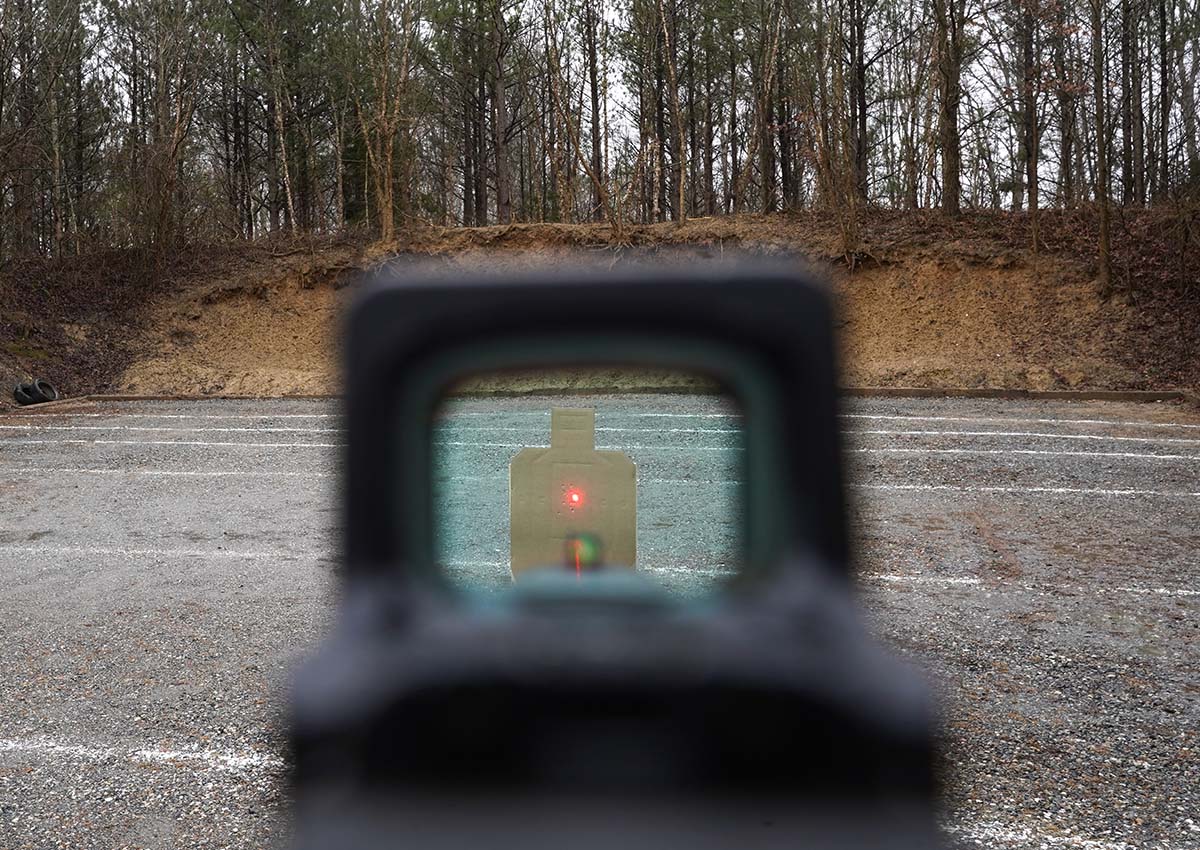
The battery door is located on the right side of the optic and is accessible without removing the red dot. Holosun says the battery life is 5,000 hours, which is about 200 days. It’s not the five-year battery life of the Holosun 507 K, but changing a battery once every six months is still pretty damn good.
The 6 moa dot on my EPS Carry is crisp and round. This is exactly how a dot should look, but many red dot sights come up short in this feature. The EPS Carry’s glass has a slight blue hue, which is common on red dots.
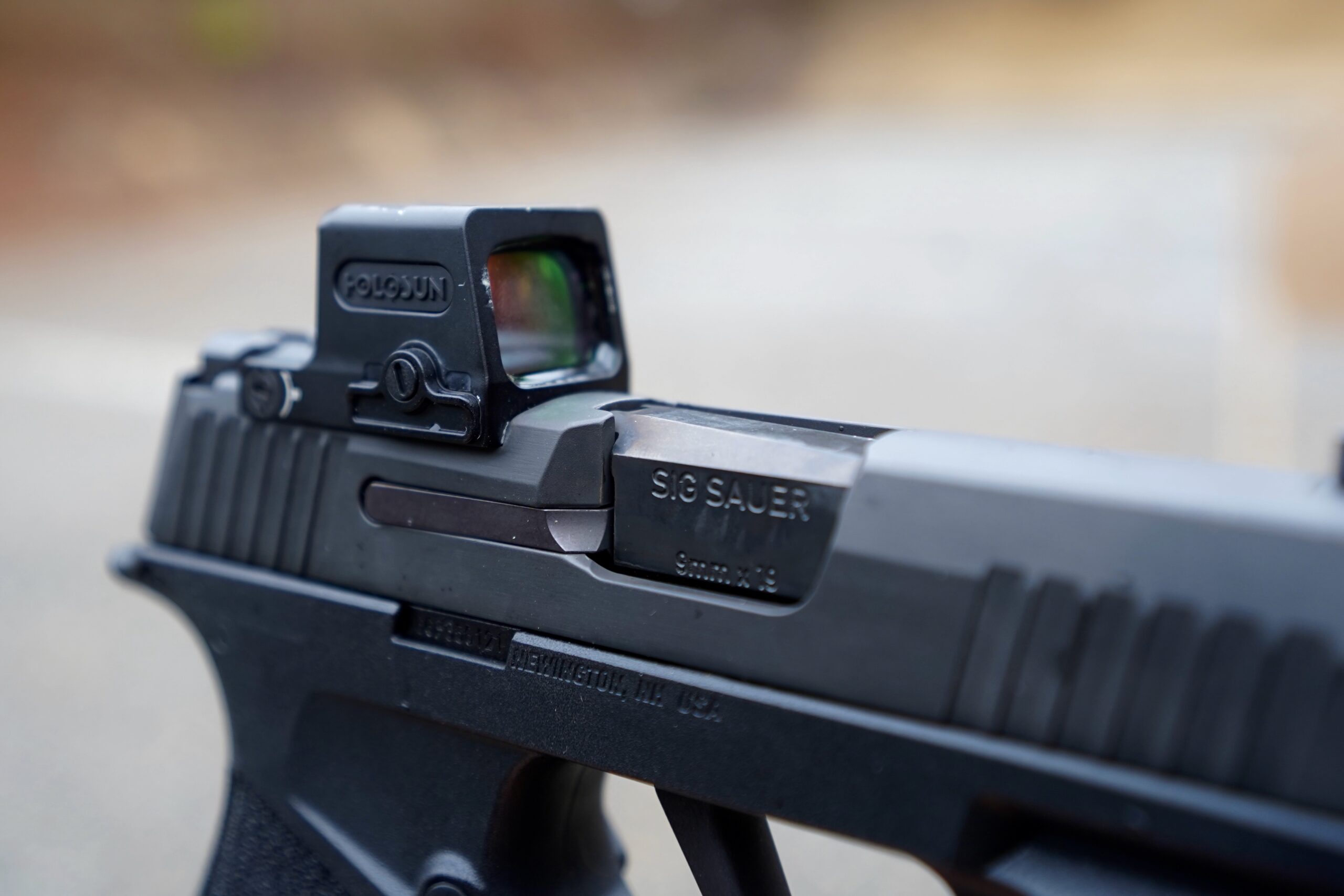
I slammed the front of the EPS Carry into my tailgate ten times to rack the slide on my empty XMacro. Then I dropped the unloaded gun from chest height so that it landed, red dot down, onto a gravel road. I picked up the handgun, loaded it, and confirmed my zero at 25 yards. The only evidence of this round of battery was some slight character marks on the housing. It held zero and functioned great throughout the rest of my range session. After a few hundred rounds, I repeated the test, and once again it was unfazed.
This isn’t a torture test meant to see if I could break the EPS Carry or to see if it’s worthy of use in the apocalypse. It’s a test that gives me confidence that if the optic takes a hard hit, it will keep its zero and continue working. -Scott Einsmann
Read the full Holosun EPS Carry review to learn more about the optic and see how it held up against the Trijicon RMR in a down pour.
Best Value: Bushnell RXS-250
Key Features
- Footprint: DeltaPoint Pro
- 4 MOA dot
- 10 brightness settings
- CR2032 battery
- 50,000 hour battery life
- IP67 rated waterproof
- Comes with Picatinny mount
- MSRP: $249.99
Pros
- Clear glass with no blue hue
- Bright
- Top loading battery
- Positive adjustment clicks
Cons
- Reticle isn’t a perfect round dot
- Brightness adjustment buttons are small
The big, clear window on the Bushnell RXS-250 makes it easy to pick up the 4 MOA dot and place it on target. The 4 MOA dot is a great balance of precision and fast acquisition. Competitive pistol shooters tend to prefer large dots, around 6 MOA, because they’re easy to see and put on target quickly. I like a slightly more precise dot than 6 MOA, and the 4 MOA is a great compromise. Whether you’re in a dark indoor range or in a blindingly-bright sand pit, one of the ten brightness settings will work for you. I find setting five to eight are the ones I use most often.
My RXS-250 doesn’t produce a perfectly round and crisp dot, but in practical use it didn’t bother me. The dot is still fine enough for precise shots and when I’m shooting fast, I’m just seeing a flash of red on the A zone anyway. Another nitpick is the brightness adjustment buttons are smaller than other red dots and a little harder to adjust on the fly.
One thing I do like is that the buttons are separated—one on the left and one on the right side. That makes it easy to adjust without looking. Speaking of great adjustments, the 1 MOA clicks for sighting in are tactile and audible. In five years when it’s time to change your battery, you don’t have to remove the optic from the mount because the battery conveniently changes from the top.
You get a lot for your money with the RXS-250. It has a bright dot, waterproof rating, large window, plenty of battery life, and it comes with a Picatinny mount.
How to Choose the Best Pistol Red Dot
When you’re shopping for a pistol red dot, you’ll likely feel overwhelmed with the choices you see. Fortunately, with some consideration, you can sort through a few qualifiers that will narrow the field and help you pick the best pistol red dot for your application.
What’s Your Intended Use?
The most important thing to consider when choosing a red dot is the specific job you need your pistol red dot to do. Is it for competition, hunting, carry, or something else? For competition, you might want a big red dot with a wide field of view. For your carry gun, size and durability will be more important. For 10mm bear defense pistols, you want a rugged optic that will hold up to recoil. In some environments, an enclosed-emitter red dot might be a better choice than an open-emitter sight. Sometimes it might not matter.
What Pistol is it For?
A frustrating part of selecting a pistol red dot is sorting through the various mounting footprints and adapters. There isn’t a universal standard for optic footprints and mounting screws, and it can seem pretty complex. There are commonly-used mounting footprints like the RMS/RMSc, Docter Noblex, and RMR standards, but some are entirely unique.
Often, your pistol will dictate which optics you can use. Some pistols that come optics-ready are only compatible with certain optics. Other pistols have adapter plates for a variety of optics available. Do your homework beforehand because your pistol choice can eliminate some of your red dot options.
Adjustability and Battery Life
Most pistol red dots have good battery life and will run for six months to a year off a CR2032 or CR2016 battery. Plan on changing batteries at least once a year as a matter of practice, but note how the batteries are changed. Although many sights have easy battery access, some need to be fully removed to change the battery. Some sights will shut off automatically when left sitting still, and others will stay running no matter what. Look at a few of them, and you’ll notice that many have adjustable brightness settings, and some adjust automatically. Buy what suits your needs best, but try to look at the sights in both dark and bright conditions. I’ve found some sights to be difficult to see in bright sunlight.
FAQs
No. You don’t need a red dot on a pistol to shoot accurately and effectively; but pistol red dots can greatly improve your speed and accuracy. Some people will still prefer iron sights, so try shooting pistols with different red dots before you buy one.
Each pistol red dot is a little different; but use the same process for zeroing any of them. After mounting the red dot, fire a single shot from a supported position at 5, 10, or 15 yards. If your shot isn’t on paper, move closer and try again. If you can see your impact, adjust the windage and elevation (horizontal and vertical) to move the bullet impact closer to the dot. Fire, adjust, and repeat until you’re zeroed, then fire a group to confirm.
Many shooters find pistol red dots to be worth the cost, and can shoot them more quickly and accurately than iron sights. They’re durable and dependable, and priceless to those who don’t have perfect vision.
Why Trust Outdoor Life?
Since 1898, OL has been a leading authority in testing and reviewing hunting gear, fishing tackle, guns and shooting equipment, and much more. We have more than a century-long history of evaluating products, and we’re now bringing that expertise to online reviews. Our editors are experienced outdoorsmen and women, and most importantly, we’re trained journalists. We prioritize field testing and objective data when reviewing products. We conduct interviews with gear manufacturers and engineers as well as outdoor experts so that our readers have an understanding of how and why a product works—or doesn’t.
Advertising does not influence our gear reviews and it never will. While we always focus our coverage on standout products—because we want our readers to be aware of the latest and greatest gear—we also cover the flaws and quirks of any given product.
Final Thoughts
A jam-packed field makes sorting through pistol red dots an intimidating task, but it also provides a lot of options. Even on a meager budget, you can likely find a sight that will fulfill your needs. There is no single best pistol red dot sight, but there’s a hell of a lot of good ones. If you consider your application, your particular pistol’s mounting options, and the features you prefer, you can find the right one for you—and you’ll probably never look back.
